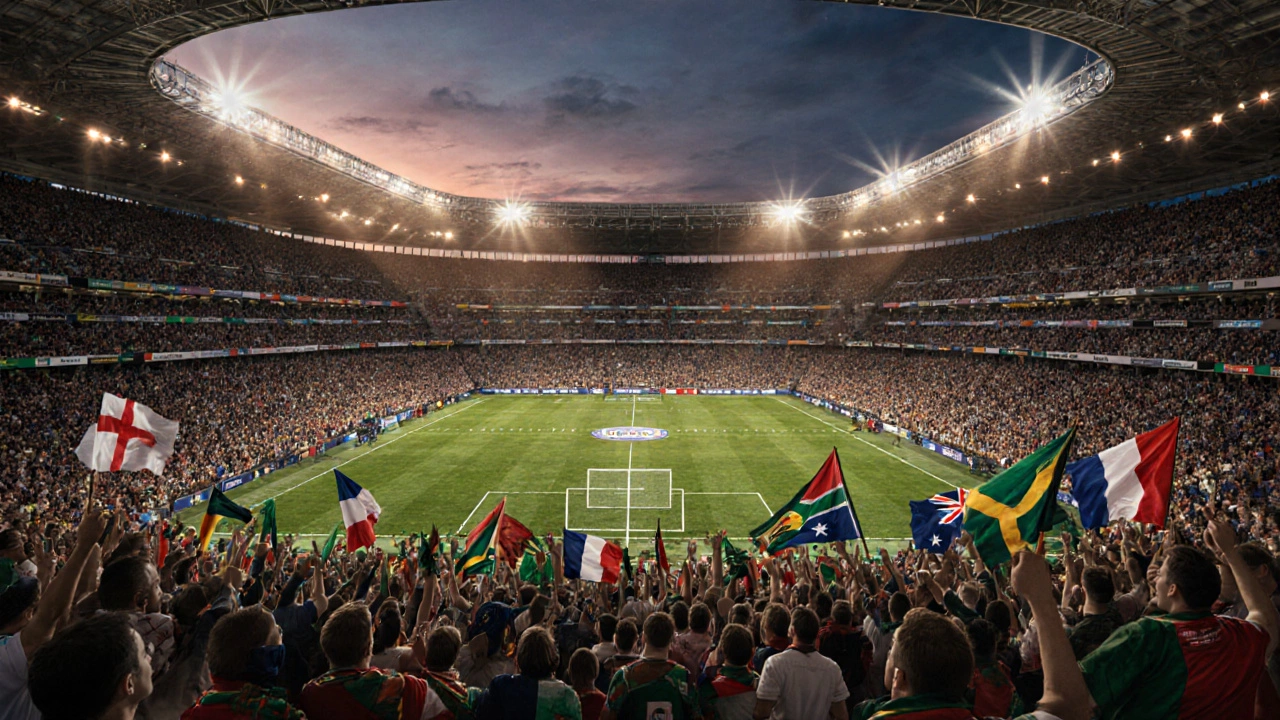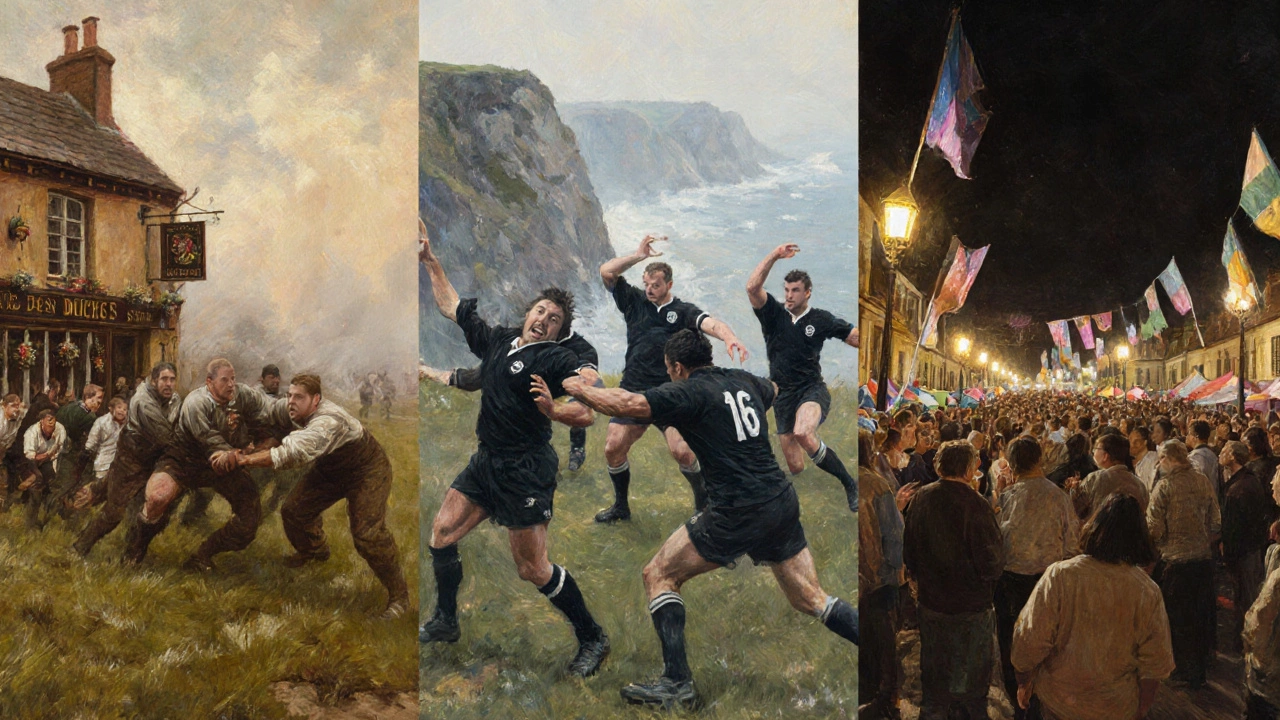
Rugby Fixtures October 19, 2025
Top Countries Where Rugby Is Most Popular
Rugby Popularity Comparison Tool
Compare Two Rugby Nations
Select two countries to see their rugby popularity metrics side-by-side
Comparison Results
Select two different countries to see the comparison
When you hear Rugby is a team sport played with an oval ball, split into Union and League codes, you might picture a scrum, a line‑out, or a cheering crowd. But which countries actually treat rugby like a religion? Below we break down the data, the history, and the cultural factors that make certain nations the heartbeat of the sport.
Why "rugby popularity" matters
Understanding rugby popularity helps fans know where the biggest matches happen, where you’ll find the most passionate supporters, and which markets attract the biggest sponsorship money. TV ratings, stadium attendance, and the number of registered players all paint a picture of a country’s love for the game.
Top rugby nations by player registrations
Registered players give the most concrete measurement of a sport’s grassroots reach. World Rugby publishes annual figures, and the latest 2024 data shows a clear hierarchy.
| Rank | Country | Registered Players | Code |
|---|---|---|---|
| 1 | England | 2,276,000 | Union |
| 2 | South Africa | 2,120,000 | Union |
| 3 | France | 1,950,000 | Union |
| 4 | New Zealand | 1,100,000 | Union |
| 5 | Australia | 1,050,000 | Union |
| 6 | Argentina | 850,000 | Union |
| 7 | Wales | 750,000 | Union |
| 8 | Ireland | 730,000 | Union |
| 9 | Scotland | 460,000 | Union |
| 10 | Japan | 320,000 | Union |
Notice the concentration in Europe and the Southern Hemisphere. Even though New Zealand’s population is small, its per‑capita registration is among the highest.
TV audience and match attendance
Broadcast numbers show where the commercial interest lies. The Rugby World Cup 2023 final pulled a global peak audience of 1.1 billion, with the UK, France, and South Africa each delivering over 20 million domestic viewers.
- England Rugby averages 12 million viewers per Six Nations match.
- South Africa Springboks games regularly sell out Bloemfontein’s 50,000‑seat Free State Stadium.
- New Zealand All Blacks boast a 95 % TV rating share during home tests.
Attendance trends mirror registration figures-countries with deep club systems fill stadiums whether it’s a local club final or a World Cup knockout.

Cultural roots that fuel the passion
Rugby didn’t just appear in these nations; it grew out of schools, military traditions, and community clubs.
In Wales, the sport is often described as a national language. The 1900s saw miners forming clubs that still exist today, making the game a social glue.
For the All Blacks, the iconic haka connects rugby to Maori heritage, turning every match into a cultural showcase.
In France, rugby thrives in the southwest, where town festivals revolve around a Saturday match.
These deep‑seated ties explain why a small uptick in performance-like a World Cup win-can cause a surge in registrations across the whole country.
Emerging markets: Where rugby is catching on fast
While the traditional powerhouses dominate the numbers, a few countries are rapidly climbing the popularity ladder.
- Japan Rugby hosted the 2019 World Cup, boosting youth participation by 30 % in five years.
- United States sees Major League Rugby stadiums filling 70 % of capacity, and the national team’s World Cup runs are sparking school programs.
- Georgia has become a European heavyweight in the forward pack, with domestic leagues expanding each season.
These markets attract new broadcast deals, meaning fans in traditional strongholds will see more international matchups on their screens.

Impact on fixtures and competitions
Popularity drives the calendar. The Six Nations, Rugby Championship, and Super Rugby all schedule matches to maximize attendance and TV revenue in the top markets.
When a nation like Argentina gains a larger fan base, the competition organizers often slot their matches into prime‑time slots to capture the new audience.
Similarly, World Rugby uses the data from emerging nations to plan future World Cup hosts, aiming for venues where the sport can grow further.
Quick checklist for new fans
- Know the top five nations by registered players: England, South Africa, France, New Zealand, Australia.
- Watch the Six Nations (Europe) and Rugby Championship (Southern Hemisphere) for the highest‑quality matches.
- Catch the Rugby World Cup every four years; it’s the ultimate showcase of global popularity.
- Follow local club leagues in emerging markets if you want to see the sport’s future.
Wrap‑up
Rugby’s popularity isn’t evenly spread, but the data is clear: Europe and the Southern Hemisphere dominate, while Asia and North America are on the rise. Whether you’re a seasoned fan or just curious, knowing where the sport lives most passionately helps you choose the right matches, the right jerseys, and the right conversations at the bar.
Which country has the most registered rugby players?
England leads with over 2.2 million registered players, according to World Rugby’s 2024 report.
Why is New Zealand considered a rugby powerhouse despite its small population?
New Zealand’s per‑capita registration is among the highest, and its national team, the All Blacks, benefits from a strong school system and cultural traditions like the haka.
How does rugby popularity affect TV broadcasting deals?
Broadcasters chase markets with the biggest audiences. High viewership in the UK, France, and South Africa drives lucrative rights packages, while emerging markets are getting new deals as viewership climbs.
Is rugby league as popular as rugby union in these top nations?
In most of the top five countries, union eclipses league. League finds strong followings in parts of England and Australia, but overall union dominates the registration and viewership figures.
What should a newcomer watch first to understand rugby’s global appeal?
Start with the Six Nations and the Rugby Championship, then catch a World Cup knockout match. Those tournaments feature the sport’s biggest nations and most intense rivalries.




